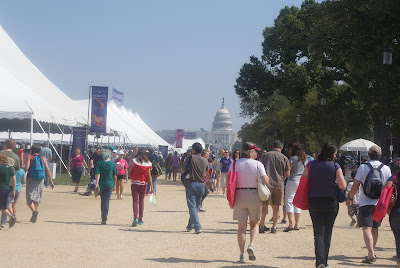9/24/12
This past weekend I visited the National Mall to attend the National Book Festival that is held there every September. It is the largest book festival in the US and features authors and poets from the US and other countries. All genres were represented including fiction, history, children, mystery, poetry, biography.
I had the privilege to hear Pulitzer Prize winners Steven Millhauser, Jeffrey Eugenides, and Marilynne Robinson speak, as well as Edgar award-winning mystery author Lisa Scottoline.
 |
| Pulitzer Prize winning author Steven Millhauser |
The National Mall is a national park administered by the National Park Service, and is commonly considered to be the area between the Lincoln Memorial and the United States Capitol, a distance of 1.9 miles.
 |
| The National Mall |
It is a stage for national events (such as Presidential inaugurations) and a national civic space for public gatherings (such as the 1963 March on Washington for Jobs and Freedom). There are many events (such as the Independence Day fireworks display), concerts, and festivals (such as the National Cherry Blossom Festival) that take place on the Mall every year, and it contains many memorials such as the Lincoln and Jefferson Memorials and the World War II Memorial. All of the Smithsonian museums that line the edges are part of the Mall.
 |
| Cherry blossom trees on the Mall |
The National Mall covers approximately 1,000 acres that the National Park Service must manage. The acreage includes the grassy areas and gravel paths at the center of the Mall, over 20,000 trees, and thousands of flowers and shrubs. Many of these trees are nationally significant, such as the 2,000 American Elms that line the Mall, and the Japanese Cherry trees around the Tidal Basin.
 |
| American Elm trees lining the Mall |
These culturally valued trees require exceptional care through a modern, urban forestry program that helps monitor the condition of the tree population. A number of methods has been used to control Dutch Elm disease that first appeared in these trees in the 1950's such as pruning, injecting trees with fungicide, replanting with DED-resistant American Elm cultivars, trapping the insect vector (the European elm bark beetle), and spraying with insecticides.
 |
| US National Botanic Garden |
There are a number of gardens on the Mall, such as the Victory Garden and Heirloom Garden at the Museum of American History, the Native Landscape at the National Museum of the American Indian, and the US National Botanic Garden.
 |
| tulips on the Mall |
Every year thousands of tulips, pansies, and annuals are planted in over 170 flower beds on the Mall. All of the attractions of the Mall make it one of the more heavily visited places in the National Park Service with approximately 25 million visitors each year. The large number of visitors requires intensive and specialized management of the park's natural resources. This brief overview is just a glimpse of the huge amount of plantings that must be managed on the Mall.


























































